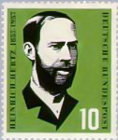 Heinrich Hertz
Heinrich Hertz 
 Heinrich Hertz
Heinrich Hertz 
Hertz always had a deep interest in meteorology, probably derived from his contacts with Wilhelm von Bezold (who was his professor in a laboratory course at the Munich Polytechnic in the summer of 1878). However, Hertz did not contribute much to the field himself except some early articles as an assistant to Helmholtz in Berlin, including research on the evaporation of liquids, a new kind of hygrometer, and a graphical means of determining the properties of moist air when subjected to adiabatic changes.
Memorial of Heinrich Hertz on the campus of the Karlsruhe Institute of Technology, which translates as At this site, Heinrich Hertz discovered electromagnetic waves in the years 1885–1889.
Main article: Contact mechanics
In 1886 ➙ 1889, Hertz published two articles on what was to become known as the field of contact mechanics. Hertz is well known for his contributions to the field of electrodynamics (see below); however, most papers that look into the fundamental nature of contact cite his two papers as a source for some important ideas. Joseph Valentin Boussinesq published some critically important observations on Hertz's work, nevertheless establishing this work on contact mechanics to be of immense importance. His work basically summarises how two axi-symmetric objects placed in contact will behave under loading, he obtained results based upon the classical theory of elasticity and continuum mechanics. The most significant failure of his theory was the neglect of any nature of adhesion between the two solids, which proves to be important as the materials composing the solids start to assume high elasticity. It was natural to neglect adhesion in that age as there were no experimental methods of testing for it.
To develop his theory Hertz used his observation of elliptical Newton's rings formed upon placing a glass sphere upon a lens as the basis of assuming that the pressure exerted by the sphere follows an elliptical distribution. He used the formation of Newton's rings again while validating his theory with experiments in calculating the displacement which the sphere has into the lens. K. L. Johnson, K. Kendall and A. D. Roberts (JKR) used this theory as a basis while calculating the theoretical displacement or indentation depth in the presence of adhesion in 1971. Hertz's theory is recovered from their formulation if the adhesion of the materials is assumed to be zero. Similar to this theory, however using different assumptions, B. V. Derjaguin, V. M. Muller and Y. P. Toporov published another theory in 1975, which came to be known as the DMT theory in the research community, which also recovered Hertz's formulations under the assumption of zero adhesion. This DMT theory proved to be rather premature and needed several revisions before it came to be accepted as another material contact theory in addition to the JKR theory. Both the DMT and the JKR theories form the basis of contact mechanics upon which all transition contact models are based and used in material parameter prediction in nanoindentation and atomic force microscopy. So Hertz's research from his days as a lecturer, preceding his great work on electromagnetism, which he himself considered with his characteristic soberness to be trivial, has come down to the age of nanotechnology.
During Hertz's studies in 1879 Helmholtz suggested that Hertz's doctoral dissertation be on testing Maxwell's theory of electromagnetism, published in 1865, which predicted the existence of electromagnetic waves moving at the speed of light, and predicted that light itself was just such a wave. Helmholtz had also proposed the "Berlin Prize" problem that year at the Prussian Academy of Sciences for anyone who could experimentally prove an electromagnetic effect in the polarization and depolarization of insulators, something predicted by Maxwell's theory. Helmholtz was sure Hertz was the most likely candidate to win it. Not seeing any way to build an apparatus to experimentally test this, Hertz thought it was too difficult, and worked on electromagnetic induction instead. Hertz did produce an analysis of Maxwell's equations during his time at Kiel, showing they did have more validity than the then prevalent "action at a distance" theories.
After Hertz received his professorship at Karlsruhe he was experimenting with a pair of Riess spirals in the autumn of 1886 when he noticed that discharging a Leyden jar into one of these coils would produce a spark in the other coil. With an idea on how to build an apparatus, Hertz now had a way proceed with the "Berlin Prize" problem of 1879 on proving Maxwell's theory (although the actual prize had expired uncollected in 1882). He used a Ruhmkorff coil-driven spark gap and one-meter wire pair as a radiator. Capacity spheres were present at the ends for circuit resonance adjustments. His receiver was a simple half-wave dipole antenna with a micrometer spark gap between the elements. This experiment produced and received what are now called radio waves in the very high
Hertz's first radio transmitter: a dipole resonator consisting of a pair of one meter copper wires ending in 30 cm zinc spheres. When an induction coil applied a high voltage between the two sides, sparks across the center spark gap created standing waves of radio frequency current in the wires, which radiated radio waves. The frequency of the waves was roughly 50 MHz, about that used in modern television transmitters.
Between 1886 and 1889 Hertz would conduct a series of experiments that would prove the effects he was observing were results of Maxwell's predicted electromagnetic waves. Starting in November 1887 with his paper "On Electromagnetic Effects Produced by Electrical Disturbances in Insulators", Hertz would send a series of papers to Helmholtz at the Berlin Academy, including papers in 1888 that showed transverse free space electromagnetic waves traveling at a finite speed over a distance. In the apparatus Hertz used, the electric and magnetic fields would radiate away from the wires as transverse waves. Hertz had positioned the oscillator about 12 meters from a zinc reflecting plate to produce standing waves. Each wave was about 4 meters long. Using the ring detector, he recorded how the wave's magnitude and component direction varied. Hertz measured Maxwell's waves and demonstrated that the velocity of these waves was equal to the velocity of light. The electric field intensity, polarity and reflection of the waves were also measured by Hertz. These experiments established that light and these waves were both a form of electromagnetic radiation obeying the Maxwell equations. Hertz also described the "Hertzian cone", a type of wave-front propagation through various media.
Hertz's directional spark transmitter (center), a half-wave dipole antenna made of two 13 cm brass rods with spark gap at center (closeup left) powered by a Ruhmkorff coil, on focal line of a 1.2 m x 2 m cylindrical sheet metal parabolic reflector. It radiated a beam of 66 cm waves with frequency of about 450 MHz. Receiver (right) is similar parabolic dipole antenna with micrometer spark gap.
Hertz's demonstration of polarization of radio waves: the receiver does not respond when antennas are perpendicular as shown, but as receiver is rotated the received signal grows stronger (as shown by length of sparks) until it reaches a maximum when dipoles are parallel.
Another demonstration of polarization: waves pass through polarizing filter to the receiver only when the wires are perpendicular to dipoles (A), not when parallel (B).
Demonstration of refraction: radio waves bend when passing through a prism made of pitch, similarly to light waves when passing through a glass prism. Hertz' plot of standing waves created when radio waves are reflected from a sheet of metal
Hertz did not realize the practical importance of his radio wave experiments. He stated "It's of no use whatsoever [...] this is just an experiment that proves Maestro Maxwell was right ➙ we just have these mysterious electromagnetic waves that we cannot see with the naked eye. But they are there."
Asked about the ramifications of his discoveries, Hertz replied, "Nothing, I guess."
Official English translation of Untersuchungen Uber die Ausbreitung der elektrischen Kraft ➙ published in 1893, a year before Hertz's death.
Hertz's proof of the existence of airborne electromagnetic waves led to an explosion of experimentation with this new form of electromagnetic radiation, which was called "Hertzian waves" until around 1910 when the term "radio waves" became current. Within 10 years researchers such as Oliver Lodge, Ferdinand Braun, and Guglielmo Marconi employed radio waves in the first wireless telegraphy radio communication systems, leading to radio broadcasting, and later television. Today radio is an essential technology in global telecommunication networks, and the transmission medium underlying modern wireless devices.
In 1892, Hertz began experimenting and demonstrated that cathode rays could penetrate very thin metal foil (such as aluminium). Philipp Lenard, a student of Heinrich Hertz, further researched this "ray effect". He developed a version of the cathode tube and studied the penetration by X-rays of various materials. Philipp Lenard, though, did not realize that he was producing X-rays. Hermann von Helmholtz formulated mathematical equations for X-rays. He postulated a dispersion theory before Rontgen made his discovery and announcement. It was formed on the basis of the electromagnetic theory of light (Wiedmann's Annalen, Vol. XLVIII). However, he did not work with actual X-rays.
![]() Excerpts From Wikipedia opens in new browser window
Excerpts From Wikipedia opens in new browser window
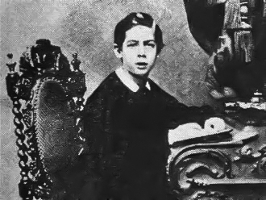 Heinrich Rudolf Hertz (22 February 1857 ➙ 1 January 1894) was a German physicist who first conclusively proved the existence of the electromagnetic waves theorized by James Clerk Maxwell's electromagnetic theory of light. The unit of frequency, cycle per second, was named the "hertz" in his honor.
Heinrich Rudolf Hertz (22 February 1857 ➙ 1 January 1894) was a German physicist who first conclusively proved the existence of the electromagnetic waves theorized by James Clerk Maxwell's electromagnetic theory of light. The unit of frequency, cycle per second, was named the "hertz" in his honor.
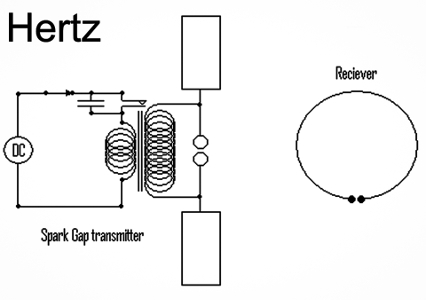 Hertz's 1887 apparatus for generating and detecting radio waves: a spark transmitter (left) consisting of a dipole antenna with a spark gap powered by high voltage pulses from a Ruhmkorff coil, and a receiver (right) consisting of a loop antenna and spark gap.
One of Hertz's radio wave receivers: a loop antenna with an adjustable micrometer spark gap (bottom).
Hertz's 1887 apparatus for generating and detecting radio waves: a spark transmitter (left) consisting of a dipole antenna with a spark gap powered by high voltage pulses from a Ruhmkorff coil, and a receiver (right) consisting of a loop antenna and spark gap.
One of Hertz's radio wave receivers: a loop antenna with an adjustable micrometer spark gap (bottom).
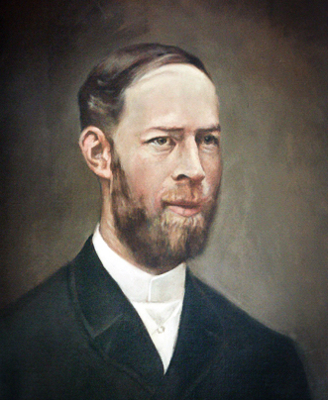 Hertz helped establish the photoelectric effect (which was later explained by Albert Einstein) when he noticed that a charged object loses its charge more readily when illuminated by ultraviolet radiation (UV). In 1887, he made observations of the photoelectric effect and of the production and reception of electromagnetic (EM) waves, published in the journal Annalen der Physik. His receiver consisted of a coil with a spark gap, whereby a spark would be seen upon detection of EM waves. He placed the apparatus in a darkened box to see the spark better. He observed that the maximum spark length was reduced when in the box. A glass panel placed between the source of EM waves and the receiver absorbed UV that assisted the electrons in jumping across the gap. When removed, the spark length would increase. He observed no decrease in spark length when he substituted quartz for glass, as quartz does not absorb UV radiation. Hertz concluded his months of investigation and reported the results obtained. He did not further pursue investigation of this effect, nor did he make any attempt at explaining how the observed phenomenon was brought about.
Hertz helped establish the photoelectric effect (which was later explained by Albert Einstein) when he noticed that a charged object loses its charge more readily when illuminated by ultraviolet radiation (UV). In 1887, he made observations of the photoelectric effect and of the production and reception of electromagnetic (EM) waves, published in the journal Annalen der Physik. His receiver consisted of a coil with a spark gap, whereby a spark would be seen upon detection of EM waves. He placed the apparatus in a darkened box to see the spark better. He observed that the maximum spark length was reduced when in the box. A glass panel placed between the source of EM waves and the receiver absorbed UV that assisted the electrons in jumping across the gap. When removed, the spark length would increase. He observed no decrease in spark length when he substituted quartz for glass, as quartz does not absorb UV radiation. Hertz concluded his months of investigation and reported the results obtained. He did not further pursue investigation of this effect, nor did he make any attempt at explaining how the observed phenomenon was brought about.
![]() Pictures
Pictures
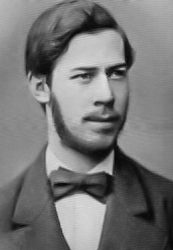
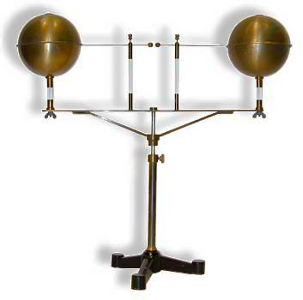
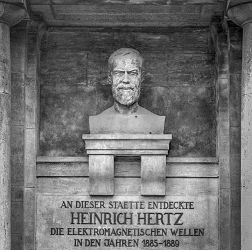
![]() Links open in new browser window
Links open in new browser window
![]() Return to Radio Pictures
Return to Radio Pictures
![]() Return to MCRN Home
Return to MCRN Home